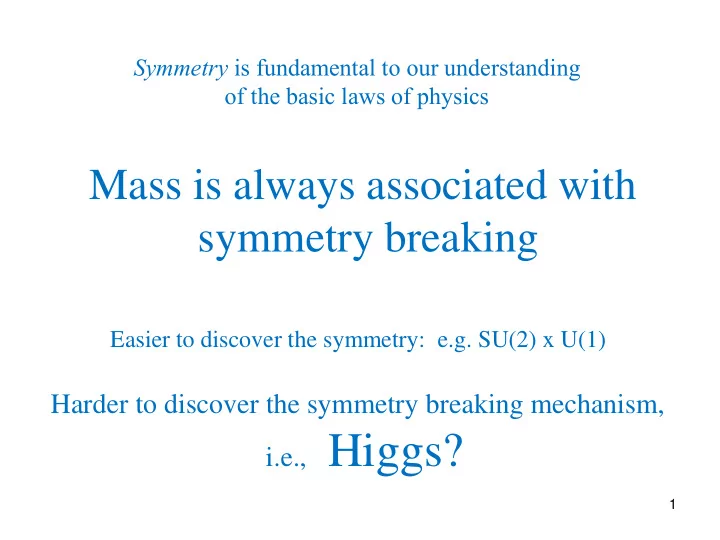

Symmetry is fundamental to our understanding of the basic laws of physics Mass is always associated with symmetry breaking Easier to discover the symmetry: e.g. SU(2) x U(1) Harder to discover the symmetry breaking mechanism, i.e., Higgs? 1
Understanding Electroweak Symmetry breaking is essential for significant progress in our understanding of the physical world. Carries major implications for: Dark Matter & Dark Energy Is there SUSY? Extra Dimensions? New Forces? Is String Theory correct? Flavor physics, masses and mixings Neutrino masses and mixings Rare processes ….. 2
Spontaneous Symmetry Breaking “hides” the SU(2) x U(1) symmetry preserves renormalizability, unitarity, good high energy behavior, etc. To understand EWSB, we must observe new particles, such as the Higgs boson. Nambu-Goldstone Bosons: “eaten” by W and Z Not finding the Standard Model (SM) Higgs boson will contradict the Standard Model and place severe constraints on the physics beyond. 3 “Higgs Boson”: radial oscillation = massive mode
The Standard Model Predicts a Low Mass Higgs Precision electroweak result: 114 < M H < 185 GeV @ 95% C.L. http://lepewwg.web.cern.ch/LEPEWWG/ This region must be thoroughly explored! 4
Status of Tevatron Higgs Searches About 25% of 114 – 185 GeV region now excluded 5
Combining all the Higgs information Most probable M H = 121 GeV
Exploring the Low Mass Region LHC and Tevatron are complementary: g LHC: gluon fusion Tevatron uses this mode for g higher mass h -> WW _ Tevatron: qq annihilation _ associated production b b 7
Standard Model Complementarity: Tevatron is sensitive to Tree Level couplings of Higgs to gauge bosons in production: b Tevatron is sensitive to Tree Level b coupling of Higgs to matter in decay 8
Standard Model Complementarity: LHC is sensitive to Loop Level (top loop) effects in production: g t t t g LHC is sensitive to Loop Level (top and W loop) effects in decay. 9
Observation of Associated Production at LHC may be possible,but requires dissecting high-ET jet substructure: Difficult: > 30 fb -1 @ 14 TeV August 19, 2009 Assuming perfect background understanding: M H = 120 GeV : 3.7 s If 15% bkgnd uncertainty, get: 3.0 s Tevatron: 3.6 s at 16 fb -1 . 10
Cocktail of backgrounds “ ” The Tevatron is ppbar; LHC is pp. For Tevatron the signal/bkgnd is better for H -> bb 11
_ H -> bb sensitivity Run-IIE > 3 sigma 16 fb -1 12
Most other processes are complementary at LHC 1 fb -1 @ 7 TeV vs. Run-IIE 13
Low mass Higgs at the LHC in the g + g mode Low int. luminosity (1 fb -1 ): Sensitivity to SM Higgs in gg requires more than 1 fb -1 @ 7 TeV. 14 Tevatron Draft
Complementarity in Theory Space Tevatron and LHC involve different processes implying different sensitivities to new physics beyond the SM MSSM: 2 Higgs doublets; more parameters M h ~ 120 GeV Tevatron LHC 15
Hints and Other Excesses Abound Example: Dzero finds evidence for matter-antimatter asymmetry in the production of muon pairs with 3.2 sigma significance. Enormous interest in science community and public. Measurement exploits perfect symmetry of proton-antiproton initial state – unique to Tevatron. More data needed. 16
CDF 17
CDF 18
CDF 19
D-Zero 20
D-Zero 21
D-Zero 22
D-Zero 23
SUMMARY • Finding the Higgs or excluding it in the favored mass region is crucial to understanding nature and to define the strategy for the future of particle physics (LHC, ILC, Muon Collider, etc.). • For several more years, the Tevatron will have excellent sensitivity to a low mass Higgs boson. • Tevatron and LHC will provide complementary information to understand EWSB; only the Tevatron will probe couplings to b in near term. • Many other legacy measurements and searches for new physics in other channels will continue at Tevatron. 24
Recommend
More recommend